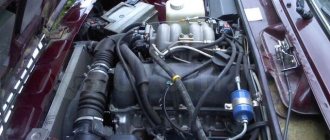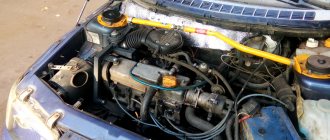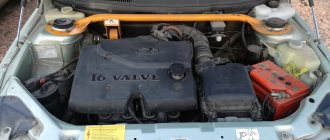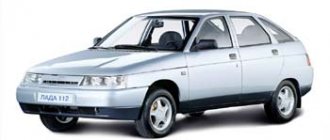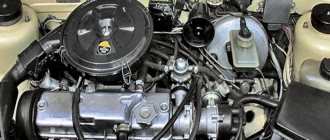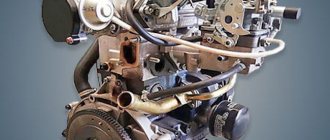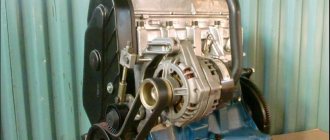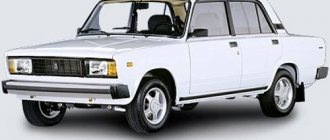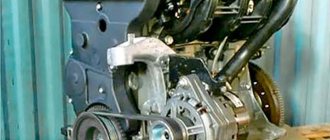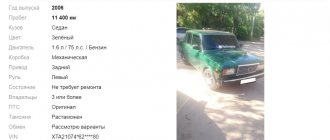The VAZ-2107 car was produced from 1982 to 2014.
Here are colored wiring diagrams (for the injector and carburetor) with a description of all the elements for various modifications. The information is intended for self-repair of cars. Electrical circuits are divided into several blocks for ease of viewing via a computer or phone; there are also circuits in the form of a single picture with a description of each element - for printing on a printer. The “sevens”, like most modern cars, use a single-wire circuit for supplying electricity to electrical equipment. The other terminal of the consumer is always connected to the ground of the machine to which the negative terminal of the battery is connected. This solution allows not only to simplify the design of the on-board network, but also to slow down corrosion.
Symptoms of a problem
A mixture misfire is a failure to ignite the fuel-air mixture or its untimely ignition. In any of the cases, the system counts the number of misses and delays, and, if necessary, turns off the idle cylinder or even a pair. On most cars, the first sign of a malfunction is the “check” symbol lighting up on the dashboard.
Also among the common signs can be noted:
- Smell of fuel from the exhaust pipe. Since the mixture did not ignite in the cylinder, it is discharged almost unchanged or partially neutralized.
- Shoots in the exhaust system. If a partial fire occurs, the catalytic converter is severely damaged, which can lead to popping noises.
- Loss of power. The engine does not work properly, causing the crankshaft to spin at a lower speed, resulting in a significant loss of power.
- Engine tripping. Failure of one or a pair of cylinders leads to the fact that the engine begins to vibrate during operation and other signs of malfunction appear.
In cars with an electronic control unit, there are several types of errors that indicate a breakdown.
- P0300. It is a sign of multiple failures in the process of ignition of the combustible mixture in different cylinders.
- P0301 - p0304. The last number shows which cylinder is not working properly.
The principle of operation of the carburetor
The functioning of the power unit is largely determined by the quantity and quality of the incoming fuel mixture.
How the 2107 carburetor works:
Fuel enters the float chamber, the level of which is regulated by a valve or float. After this, the gasoline, divided into droplets, enters the mixing chamber through nozzles, where mixing with the air occurs. The econostat further enriches the mixture when the engine is running at full load. Diffusers optimize the flow of fuel, which is supplied to the manifold through the throttle valves. When the engine runs at high speeds, the accelerator pump turns on.
VAZ 21074 engine control system diagram
Wiring diagram of electrical connections of ECM VAZ 21074 - circuit elements. 1 — controller connector; 2 — mass air flow sensor; 3 — coolant temperature sensor; 4 — crankshaft position sensor; 5 — throttle position sensor; 6 — oxygen concentration sensor; 7 — speed sensor; 8 — ignition module; 9 — solenoid valve for purge of the adsorber; 10 — electric fan relay; 11 — electric fuel pump relay; 12 - main relay; 13 - fuse for the power circuit of the electric fuel pump relay: 14 - fuse for the power circuit of the main relay; 15 — fuse-link; 16-fuse protecting the constant power supply circuit of the controller; 17 - diode; 18 — idle speed regulator; 19 — nozzles; X1 - diagnostic block; X2 - connection block to the vehicle electrical system.
Step-by-step instructions for disassembling the internal combustion engine of a car + Video
- Prepare all the necessary tools and drain the oil from the crankcase.
- Firstly, this will be necessary to lighten the weight of the motor, and secondly, it will help to avoid excess dirt on the workbench. Next, unscrew the oil filter. Also unscrew all the bolts that secure the oil pan. The old gasket can be thrown away as it is no longer suitable for further use.
- Now you need to remove the crankshaft pulley. This is not as easy to do as it seems at first glance, since in this case you will need good physical strength. However, no one has canceled the use of a pipe as a wrench extension. Secure the crankshaft from turning by blocking the flywheel. For this, a special device is used, which can be purchased in the store. Next, use a wrench to unscrew the ratchet and remove the pulley.
- Unscrew the nuts securing the valve covers and timing chain, remove it and pull out the gasket. Unscrew the bolts securing the camshaft gears, as well as the shaft that drives the engine oil pump. Next in line is the timing chain tensioner. First, loosen the special cap nut, and then unscrew the other two nuts that secure it to the cylinder head. Do not forget to unscrew the bolt securing the shoe, and then remove the tensioner itself, along with the shoe. Then the pin that restricts the chain is unscrewed, the camshaft and oil pump gears are removed, and the chain is removed.
- Now you need to remove the camshaft. To do this, unscrew two nuts located on its studs in the bearing housing. The housing must be removed and the camshaft carefully pulled out. Before pulling it out, do not forget to also remove the special thrust flange.
- Next, the bolts intended to secure the cylinder head to the block itself are unscrewed. The cylinder head is dismantled immediately along with the manifolds, which are not required to be removed (depending on the type of repair being carried out). After removing the head, it is also recommended to replace the gasket. This procedure will help you, in the future, get rid of repeated removal of this element.
- After this, you need to dismantle the oil pump. To pull it out you need to remove the special thrust flange. After this, remove the roller from the cylinder block, which is responsible for driving the oil pump.
- Using a special removable device, remove the gear that fits onto the engine crankshaft. Then remove the nuts located on the connecting rod bolts. Now remove the connecting rod caps and, using the cylindrical opening, pull out the connecting rods along with the pistons.
Attention! Before removing the connecting rods and pistons, as well as the main bearings and liners, you must first mark them all to prevent errors when assembling the element.
- We return to the flywheel retainer again and install it. Unscrew the bolts that are intended for fastening and remove the washer, then pull out the flywheel mounted on the crankshaft, and then remove the protective cover of the clutch housing.
- Using a puller, remove the gearbox input shaft bearing, which is located in a special socket at the rear of the power unit. Next you need to pull out the special crankshaft oil seal holder. Now unscrew the bolts that secure the caps covering the main bearings and pull them out along with the liners. After this, you need to remove the crankshaft and the uppermost shaft bearings. Also remove the special thrust half-rings that are located on the support.
That's all you need to do to disassemble the engine. The next step is to bore various elements to repair sizes and replace damaged and worn elements. It is recommended to pay special attention to the liners, which are most often subject to rotation, which is why the motor simply jams. After repair, the engine is assembled and installed on the car.
Characteristics of oils for VAZ
The service life of the engine depends on the correct selection of oil for injection VAZ 2107. The recommended quality standard for the lubricating fluid is given by the manufacturer. Any type of oil that meets API SJ/CF, SG/CD quality standards can be filled into the car.
The abbreviation API means that a lubricant meets the following basic criteria:
- cleaning properties;
- temperature regime;
- indicator of deposits on engine components before the first oil change;
- release of harmful substances;
- corrosive properties;
- effectiveness of protecting components from friction.
It is recommended to use the following types of oils.
| Oil brand for VAZ | SAE viscosity groups | API standard |
| RAVENOL LLO | 10W-40 | SJ/CF |
| SHELL HELIX SUPER | 10W-40 | SG/CD |
| TNK SUPER OIL | 5W-40, 10W-40, 15W-40, 20W-40 | SG/CD |
| TOTAL QUARTZ | 5W-40, 10W-40 | SL/SF |
| MOBIL SUPER M | 15W-40 | SJ/CF |
| LUKOIL LUX | 5W-40, 10W-40, 15W-40 | SJ/CF-4 |
| NOVOIL-SINT | 5W30 | SG/CD |
| CONSOL | 5W-40, 10W-40, 15W-40 | SG/CD |
| BIZOL GREEN OIL | 10W-40 | SL/SF |
| ESSO ULTRA | 10W-40 | SJ/CD |
| LUKOIL SUPER | 5W-40, 10W-40, 15W-40, 10W-30 | CF-4/SG |
| RAVENOL SUPER HD | 15W-40 | SJ/CF |
| LUKOIL SUPER | 5W-30, 5W-40, 10W-40, 15W-40 | SG/CD |
| ANGROL-SUPER | 5W30, 5W-40, 10W-40 | SG/CD |
| LUX | 5W30, 5W-40,10W-30, 10W-40, 15W-40, 20W-40 | SG/CD |
| ESSO UNIFLO | 10W-40, 15W-40 | SJ/CD |
Features of operation and maintenance
- Fuel selection
It was said earlier that many drivers cannot decide on the type of fuel used for their engine on the VAZ 2107. And if with AI-92 everything is simple, since its composition is very similar to AI-93, then with AI-95 everything is not so smooth.
Increasing the octane number leads to an increased risk of valve burnout, but gives a small increase in power. The engine begins to run smoother and more stable.
But the designers still took into account the possibility of using AI-95 gasoline. You just need to correctly set the ignition timing on your car (if you have a conventional carburetor engine) or reflash the engine control unit (if your VAZ 2107 engine is fuel-injected). But usually even this is not required. Engines of this brand are very durable and not picky about the type of fuel (within reasonable measures).
- Change of oil
Changing the oil on any engine must be approached with the utmost seriousness.
Poor quality oil can lead to not very pleasant consequences, such as accelerated wear of main components and assemblies. The ability to select oil is a real skill. Taking well-known brands is not always safe, since you are very likely to come across a counterfeit from dishonest companies. At best, you will not receive the positive qualities that this company has. At worst, you will have to carry out major repairs.
You shouldn't buy unknown brands either. In this case, you are buying a pig in a poke. You can buy oil that is of a quality that is not inferior to expensive analogues, or you can end up with expensive repairs. It is best to buy oil in specialized stores, where you can get at least some explanation and compensation.
Another important parameter is the oil class according to the international nomenclature. True, everything is simpler here. You just need to take the oil that the manufacturer himself recommends.
The manufacturer (AvtoVAZ) for VAZ 2107 engines and other models with this type of engine recommends:
- 5W-30;
- 5W-40;
- 10W-40;
- 15W-40.
You need to take about 4 liters of oil. When changing 3.5 liters of oil is usually enough. It’s better to carry the rest with you in the trunk, since oil consumption in this engine leaves much to be desired.
- Changing the oil in the VAZ 2107 engine
The procedure itself is quite simple and should not raise any questions. It is better to change the oil on a VAZ 2107 in the warm season.
- First you need to start the car and warm it up to operating temperature. Then turn it off and let the oil fall back into the crankcase. This will take about half an hour. During this time, we prepare a receiving container with a volume of 4-5 liters, as well as new oil, a watering can and a hose.
- Use a special wrench to unscrew the plug on the crankcase and wait for the old oil to drain out.
- If you change the type of oil or brand, you must also take flushing oil, which will clean the engine of the remnants of the old one. We pour it in the same way.
- Then we tighten the crankcase cover and fill in new oil through the neck on the cylinder head. We measure the level with a dipstick. It should be somewhere between the MIN and MAX marks. Please note that oil is not water and it cannot quickly sink into the crankcase, and therefore after a short stop the oil level in the crankcase will rise a little more.
Usually, along with changing the oil, the oil filter is also changed. It's even simpler here:
- We unscrew the old one using a special tool (you can also use an ordinary rope), lubricate the o-ring of the new filter with oil and screw it in place of the old one.
- Adjustment of valves
Adjusting valves is a rather complicated process and requires certain skills and tools. Actually, it is advisable to entrust the valve adjustment itself to competent specialists, but if you want to do everything yourself, then this video is for you:
Major repairs and maintenance
If valve adjustment can be done at home, then major engine repairs should only be entrusted to specialists.
During a major overhaul, all components and assemblies of the VAZ 2107 engine are checked for serviceability. They will check for you:
- Valve condition, adjustment;
- Chain, chain tension;
- Condition of oil seals, valve stem seals;
- Geometry of the cylinder block;
- Condition of the pistons, crankshaft, pins, connecting rods;
- Wear of compression rings;
- Condition of the oil pump and coolant pump.
If damaged, the part will be replaced. The cylinder block will be bored out, which will increase the combustion chamber and working volume. After this procedure, the car will be run-in for several thousand kilometers.
Typically, running-in lasts 5-10 thousand km. At this time, it is not advisable to give the engine heavy loads. After completing this procedure, your engine will make you happy.
Malfunctions
1. Engine won't start
| Cause of failure | Elimination method |
| No fuel in carburetor | |
| Fuel line clogged | Blow out the fuel line, flush the fuel tank |
| Carburetor and fuel pump filters are clogged | Wash filters and replace if necessary |
| Ignition system is faulty | Check the ignition system, replace broken parts |
| The carburetor air damper does not open at the first flashes in the cylinders | Eliminate leaks in the carburetor starting device |
| The carburetor solenoid valve does not open when the ignition is turned on: | |
| break in the wire going to the valve | Check the wire and its connections, replace the damaged wire |
| solenoid valve faulty | Replace valve |
2. Knock of the crankshaft main bearings. Usually a dull, metallic knock. It is detected when the throttle valves are opened sharply at idle. Its frequency increases with increasing crankshaft speed. Excessive axial clearance of the crankshaft causes a sharper knock with uneven intervals, especially noticeable with a gradual increase and decrease in the crankshaft speed.
| Cause of malfunction | Elimination method |
| Ignition too early | Adjust the ignition timing |
| Insufficient oil pressure | Check oil pressure |
| Flywheel mounting bolts are loose | Tighten the bolts to the recommended torque |
| Increased clearance between journals and main bearing shells | Sand the journals and replace the bearings |
| Increased clearance between thrust rings and crankshaft | Replace thrust half-rings with new ones or thicker ones |
Engine tuning
The most popular types of tuning for engines of this type are increasing the displacement, replacing the camshaft, installing a zero-resistance filter and direct-flow exhaust.
The most effective way (and the most expensive) is to install a turbo kit.
- Increase in working volume
The design of the VAZ 2103 engine allows for a good increase in displacement, since its cylinder block is almost identical to the VAZ 2106 engine block. And when this block is bored, it can be made to fit the piston and rings of the VAZ 2106 engine.
Thus, we get an increase in displacement, which increases fuel consumption and power. If even this is not enough, then they sharpen the pistons on the valve side and install a crankshaft from the Niva, which also increases the working volume. Presumably after these operations you can get an engine with a displacement of 1.7 liters, sometimes 1.8 liters.
- Installing a new camshaft
This modification does not increase engine power, but changes the nature of its operation. In most cases, they try to install a camshaft that will transfer maximum torque to as low a speed as possible. This makes the engine more responsive at lower speeds, which has a very good effect when driving at low engine speeds. The best option for such a modification is a camshaft from Niva 21213.
- Installation of direct-flow exhaust and zero-resistance filter
The most popular modification. First of all, it's pretty cheap. Secondly, it allows the car owner to show off to neighbors in the garages. In fact, it does not have any practical benefit for the stock engine. Allows you to feel a slight increase in power only at high speeds.
It is quite effective when installing Turbo, since it does not put pressure on the engine, which is now capable of developing enormous power. Direct-flow exhaust is not convenient due to increased exhaust sound. It is dangerous to use the filter in wet weather, as it can let water into the engine, causing water hammer.
- Installation of turbocharging
The most expensive and effective way to increase engine power, while its resource sharply drops by 2-3, sometimes 4-5 times.
Requires deep exhaust tuning:
- Installing T-Valves
- Imported rings and forged pistons
- Lightened crank feces
- Intercooler and much more.
It is also necessary that your VAZ 2107 engine be fuel-injected. The carburetor can simply burst due to such high pressure. This article will not describe the procedure for installing Turbo on a VAZ 2107. There is enough such information on the World Wide Web. Here we will simply indicate a price of approximately 15% of the cost of the car. If you are ready to spend your money on this, go for it.
Wiring harness in the cabin
In the interior of the VAZ 21074 there are wiring harnesses:
- under the instrument panel. This bundle contains the wires responsible for the headlights, direction indicators, instrument panel, and interior lighting;
- stretched from the fuse box to the rear of the car. The wires of this bundle power the rear lights, glass heater, and gasoline level sensor.
The wires that are used in the “seven” for electrical connections are of the PVA type and have a cross-section from 0.75 to 16 mm2. The number of copper wires from which the wires are twisted can range from 19 to 84. The wiring insulation is made on the basis of polyvinyl chloride, which is resistant to temperature overloads and chemical influences.
The wiring harness under the instrument panel of the VAZ 21074 contains wires that are responsible for the headlights, direction indicators, instrument panel, and interior lighting.
To simplify the repair, maintenance and replacement of electrical equipment, the factory electrical wiring of VAZ 21074 vehicles has a set color.
Table: cross-section and color of wiring of the most important electrical appliances VAZ 21074
| Electrical circuit section | Wire cross-section, mm2 | Insulation color |
| minus battery - body mass | 16 | black |
| starter plus - battery | 16 | red |
| plus generator - battery | 6 | black |
| generator—black connector | 6 | black |
| terminal “30” of the generator—white block MB | 4 | pink |
| terminal “50” starter—starter start relay | 4 | red |
| Starter start relay—black connector | 4 | brown |
| ignition relay—black connector | 4 | blue |
| terminal “50” of the ignition switch—blue connector | 4 | red |
| terminal “30” of the ignition switch—green connector | 4 | pink |
| right headlight connector - ground | 2,5 | black |
| left headlight connector—blue connector | 2,5 | green (gray) |
| terminal “15” of the generator—yellow connector | 2,5 | orange |
| Radiator fan ED - “ground” | 2,5 | black |
| Radiator fan ED—red connector | 2,5 | blue |
| contact “30/1” of the ignition switch—ignition relay | 2,5 | brown |
| pin “15” of the ignition switch—single-pin connector | 2,5 | blue |
| cigarette lighter—blue connector | 1,5 | blue (red) |
Engine for VAZ-21067, 2104, 2105, 21053, 2107 (injector) buy new
Buy new VAZ-21067 engine
For VAZ 2104-2107
Engine assembly
The engine plus everything that is attached to it: a generator with a mount (bracket), a distributor (if any), a carburetor, a fuel pump (if a carburetor), coils and wires, intake and exhaust manifolds (on the carburetor).
On the injector: receiver, intake and exhaust manifold (catalog manifold), throttle valve (if injector), all rubber hoses, all small brackets, all belts: generator, toothed, on classic engines: - chain. Dipstick
Break-in oil (10v40 semi-synthetic Lukoil, recommended after running in 1000-1500 km, oil change).
On the injector: a ramp with injectors and injector wiring; on a 16-valve engine, the kit includes 4 ignition coils with a wiring harness.
Packaging: everything is mounted on a wooden stable pallet, screwed on, the engine itself is made of cardboard on all sides and wrapped with stretch film. The transport company is packed in a wooden box.
Cost of VAZ 21067 engine injector
- Cylinder block assembled with piston group and crankshaft - 42,000 rubles.
- Cylinder block assembly, cylinder head assembly, without attachments - RUB 74,000.
- Engine assembled with attachments - 94,000 rubles.
We ship with a 10% prepayment throughout Russia! If you are at a loss with a choice, then write to our manager in the chat or request a call back
Have you watched recently
We deliver throughout Russia and Kazakhstan by transport companies
List of delivery cities
Abakan Adler Almetyevsk Angarsk Apatity Arzamas Armavir Arkhangelsk Asbest Astrakhan Achinsk Balakovo Balashikha Barnaul Belgorod Beloretsk Berdsk Berezniki Biysk Blagoveshchensk Borisoglebsk Borovichi Bratsk Bryansk Buzuluk Velikiye Luki Veliky Novgorod Vladivostok Vladikavkaz Vladimir Volgograd Volgodonsk Volzhsky V ologda Vorkuta Voronezh Voskresensk Votkinsk Vsevolozhsk Vyborg Gatchina Glazov Gorelovo Grozny Dzerzhinsk Dimitrovgrad Dmitrov Domodedovo Yeysk Ekaterinburg Zheleznodorozhny Zabaikalsk Zelenograd Zlatoust Ivanovo Izhevsk Irkutsk Yoshkar-Ola Kazan Kaliningrad Kaluga Kamensk-Uralsky Kamensk-Shakhtinsky Kamyshin Kachkanar Kemerovo Kerch Kirov Kirovo-Chepetsk Klin Klintsy Kovrov Kolomna Kolpino Komsomolsk-on-Amur Kostroma Kotlas Krasnogorsk Krasno dar Krasnokamsk Krasnoyarsk Kuznetsk Kumertau Kurgan Kursk Leninsk -Kuznetsky Livny Lipetsk Magnitogorsk Maykop Makhachkala Miass Moscow Murmansk Murom Mytishchi Naberezhnye Chelny Naro-Fominsk Neftekamsk Nizhnevartovsk Nizhnekamsk Nizhny Novgorod Nizhny Tagil Novokuznetsk Novomoskovsk Novorossiysk Novosibirsk Novocheboksarsk Novocherkassk Novy Urengoy Noginsk Noyabrsk Obninsk Odintsovo Oktyabrsky Omsk Orel Orenburg Orekhovo-Zuevo Orsk Penza Pervouralsk Perm Petrozavodsk Podolsk Pskov Pushkin Pushkino Pyatigorsk Roslavl Rossosh Rostov-on-Don Rybinsk Ryazan Salavat Samara St. Petersburg Saransk Saratov Sevastopol Severodvinsk Sergiev Posad Serov Serpukhov Simferopol Smolensk Solnechnogorsk Sosnovy Bor Sochi Stavropol Stary Oskol Sterlitamak Stupino Surgut Syzran Syktyvkar Taganrog Tambov Tver Tobolsk Togliatti Tomilino Tomsk Tula Tyumen Ulan- Ude Ulyanovsk Usinsk Ussuriysk Ust-Kut Ufa Ukhta Khabarovsk Khanty-Mansiysk Tchaikovsky Cheboksary Chelyabinsk Cherepovets Chekhov Chita Mines Sheremetyevo Engels Yaroslavl
What generators can be installed on the “seven”
The design of the VAZ 2107 allows the installation of not only the G-221A generator. Therefore, if necessary, the driver can install a more powerful device, however, this will require making some changes to the electrical circuit of the car. The question arises: what is the reason for the desire of a car enthusiast to change his “native” generator?
The G-221A was the optimal device for equipping cars at the beginning of their mass production. However, a lot of time has passed since the 1980s and today almost every driver uses modern electronic devices:
- acoustic system;
- navigators;
- additional lighting devices (tuning), etc.
Accordingly, the G-221A generator cannot cope with high loads, which is why drivers begin to look for more powerful units.
You can install at least three more powerful devices on the “seven”:
- G-222 (generator from Lada Niva);
- G-2108 (generator from the G8);
- G-2107–3701010 (injection model for a carburetor car).
It is important that the last two models do not require changes in the design of either the generator housing or its mountings. When installing a generator from Niva, you will have to make some modifications
Connection diagram G-221A
Being an electronic device, the generator needs to be used correctly. Therefore, its connection diagram should not cause ambiguity. It should be noted that drivers of “sevens” can usually easily connect all the generator terminals themselves, since the circuit is accessible and understandable to everyone.
The generator (item 2) is connected to the circuit in series between the battery (item 1) and the mounting block (item 3)
Many car owners wonder where which wire should be connected when replacing the generator. The fact is that the device has several connectors and wires, and when replacing, you can easily forget which wire goes where:
- orange is not useful for connection, it can be left as is or connected to gray directly to autostart the car;
- a gray thick wire goes to the brushes from the relay regulator;
- a gray thin wire connects to the relay;
- yellow - coordinator of the control light on the control panel.
When working independently with the G-221A, it is better to sign the purpose of the wires so as not to connect them by mistake later.
To avoid errors, all wires have their own color designation
Removing the carburetor
However, before you start cleaning the carburetor, you need to disassemble it, following a sequential procedure.
Using an “11” wrench, unscrew the bolt securing the liquid chamber housing to remove the semi-automatic starting device. Remove it together with the sealing rubber ring. Using a screwdriver with a sharp tip, pry off the retaining ring of the air damper drive lever. Then we pry up and remove the locking wheel of the throttle valve of the first chamber. We press on the levers and rods, disengaging them from each other. Unscrew the three screws securing the starter housing with a Phillips screwdriver. Remove the starting device assembly. It is not recommended to disassemble this device.
You can disassemble the carburetor without removing the starter. To do this, you will need to disconnect the lower lever of the starting device, and then use a Phillips screwdriver to unscrew the five screws securing the cover.
Use a hammer to knock out the axle with a float using a drift. Remove the cover gasket. We turn out the needle valve body with a spanner “11”. We take it out and the copper o-ring. We unscrew the inlet fitting with a “15” wrench and remove it together with the sealing ring. Using a 13 key, unscrew the solenoid valve and remove the idle jet. Unscrew the screw securing the throttle body heating unit. We turn out the main air and fuel jets. Remove the accelerator pump nozzles. Fuel jets can simply be shaken out of the wells.
Using a Phillips screwdriver, unscrew the three screws securing the economizer cover. After removing the cover, take out the spring and diaphragm. Using a screwdriver, unscrew the economizer nozzle and remove it. Unscrew and remove the four screws securing the accelerator pump cover. Next, remove the diaphragm along with the return spring. Now you can unscrew the screw of the plastic wire holder of the EPHH screw sensor and remove the wire. Unscrew the throttle valve stop screw. Then unscrew the screw securing the sector and the damper control lever. We remove the unscrewed lever and, applying considerable force, the sector. We remove the rod by unscrewing the screw securing it. Using a narrow screwdriver, unscrew the mixture quality adjustment screw and remove it along with the rubber o-ring. Finally, remove the rubber o-ring from the fuel intake pipe of the idle system.
That's all! The carburetor is ready for cleaning, adjustment of individual parts and complete tuning.
Preventative work
There are quite a few components in 2107 that require attention. In order to prevent the operation of the carburetor, it is cleaned and all systems are adjusted. For ideal operation, the VAZ 2107 carburetor setting itself must be ideal! It is not surprising that the mechanism quickly becomes clogged. This occurs when dust particles passing through the air filter collide with oil droplets. This mixture very often settles on the carburetor body. Dirt flakes can get into the float chamber and also clog the jets. Try to check the carburetor from time to time.
To prevent this problem, they came up with one way. To prevent dirt from getting into the balancing holes, they need to be raised a couple of millimeters higher. For this you can use polyethylene tubes with a thickness of 1 mm and a diameter of 5 mm. They must be inserted into the holes so that their protrusion on the side of the floats reaches 2-3 mm. Using a soldering iron, you need to flare them. The second end of the tubes may coincide with or be higher than the cap.
This modification ensures that now large enough dirt particles will not be able to get into the camera. The jets will also not become clogged with them.
Repair kit
In order not to worry once again that your carburetor may be damaged in the most inopportune place, it is recommended to always have a repair kit with you. It will help you easily and cost-effectively repair a faulty element. Most often, problems can be caused by wear of gaskets, valves, and diaphragms. Many of the car parts are subject to wear: battery, timing belt, cylinder head parts, hydraulic compensator, generator (brushes), muffler, panel. Even if it is a miniature device, like the ignition relay, which is used to turn on the starter, it still plays an important role. And usually all repairs boil down to the fact that these parts are successfully replaced. In most cases, these kits contain everything you need.
Explanation of symbols
- 1 – radiator fan drive motor;
- 2 – mounting block block;
- 3 — idle speed sensor;
- 4 – engine ECU;
- 5 – potentiometer;
- 6 – set of spark plugs;
- 7 – ignition control unit;
- 8 – electronic crankshaft position sensor;
- 9 – electric fuel pump;
- 10 – indicator of the number of revolutions;
- 11 – lamp for monitoring the health of electronic systems and the brake system;
- 12 – ignition system control relay;
- 13 – speedometer sensor;
- 14 – special factory connector for reading errors using the BC;
- 15 – injector harness;
- 16 – adsorber solenoid valve;
- 17, 18, 19,20 – fuse box for repairing the mounting block that protects the injection system circuits;
- 21 – electronic fuel pump control relay;
- 22 – electronic relay for controlling the exhaust manifold heating system;
- 23 – exhaust manifold heating system;
- 24 – fuse protecting the heater circuit;
- 25 – electronic air sensor;
- 26 – coolant temperature control sensor;
- 27 – electronic air damper sensor;
- 28 – air temperature sensor;
- 29 – pressure control sensor and low oil pressure lamp.
How and why should you disassemble the engine?
Engine disassembly is carried out if the engine is planned to undergo a major overhaul. At the same time, it must be completely disassembled and all worn elements replaced. In addition, boring the cylinder block, which must be freed from all parts of the engine, will be relevant. In addition, you can disassemble the engine in order to simply clean it, in case of serious contamination, when it is not possible to get by with simple flushing oil.
We will try to omit the details regarding its removal, since this is quite simple to do: you just need to unscrew the nuts 19 from the cushions, remove the attached parts (all parts of electrical equipment, hoses and pipes, as well as drives of various elements) and unscrew it from the gearbox. After this, the motor is thoroughly washed and installed on a special stand (the use of a regular workbench is also welcome).
General diagram of the electrical equipment of the VAZ 21074 injector
General diagram of the electrical equipment of the VAZ 21074 injector
1. Electrical connection diagram of the wiring harness of the instrument panel assembly LADA 21074
- — ignition switch unloading relay;
- — relay-interrupter of direction indicators;
- — windshield wiper relay;
- — brake signal switch;
- — switch for headlights and direction indicators;
- — windshield wiper and washer switch;
- — ignition switch;
- - hazard warning switch;
- — instrument cluster;
- — rear window heating switch;
- — rear fog light switch;
- — external lighting switch;
- — heater motor switch;
- — additional resistor for the heater electric motor;
- — heater electric motor;
- — indicator lamp for heated rear window;
- — brake fluid level warning lamp;
- — instrument lighting switch;
- - cigarette lighter;
- - watch;
- - reverse light switch;
- — hand brake sensor;
- — rear fog light relay;
- — block of the instrument panel harness to the ignition system harness;
- — glove box lighting;
- — mounting block.
A1, A2 - grounding points of the instrument panel wiring harness. A3 - grounding points for the heater motor.
2.Electrical connection diagram of ECM LADA 21074 injector
1 - controller; 2 — diagnostic oxygen concentration sensor; 3 — block of the ignition system harness to the right mudguard harness; 4 — block of the fuel level harness to the ignition system harness; 5 and 7 — electrical fuel pump harness pads; 6 — control oxygen concentration sensor; 8 — electric fuel pump; 9 — diagnostic block; 10 — speed sensor; 11 — idle speed regulator; 12 — throttle position sensor; 13 — coolant temperature sensor; 14 — mass air flow sensor; 15 — crankshaft position sensor; 16 — solenoid valve for purge of the adsorber; 17 — ignition coil; 18 — spark plugs; 19 — nozzles; 20 — block of the ignition system harness to the instrument panel harness; 21 — controller power supply fuse; 22 — ignition relay; 23 - ignition relay fuse; 24 — fuse for the electric fuel pump power supply circuit; 25 — electric fuel pump relay; 26 — block of the ignition system harness to the injector harness; 27 — injector harness block to the ignition system harness; A - to the “plus” terminal of the battery; B1 — grounding point of the fuel level sensor harness; B2, ВЗ — grounding point of the ignition system harness; 21074-3724026 — ignition system harness
3. Electrical connection diagram of the wiring harness of the right mudguard assembly LADA 21074.
- — mounting block;
- — block of the right mudguard harness to the left mudguard harness;
- — right side turn signal;
- - right headlight;
- — additional starter relay;
- — windshield washer pump;
- — blocks of the right mudguard harness and connecting starter wires;
- — starter;
- — rechargeable battery;
- — generator.
A1 is the grounding point for the right mudguard wiring harness. A2, A3 - grounding points of the connecting motor wire with the battery and housing.
4. Electrical connection diagram of the left mudguard assembly wiring harness LADA 21074.
- — mounting block;
- — block of the left mudguard harness to the right mudguard harness;
- - left headlight;
- — left side turn signal;
- — oil pressure warning lamp sensor;
- — coolant temperature sensor;
- — brake fluid level sensor;
- — electric motor of the windshield wiper;
- - sound signal;
- — engine electric fan.
A1, A2 - grounding points of the left mudguard wiring harness.
5. Electrical connection diagram of the flat rear wiring harness assembly for LADA 21074.
- — mounting block;
- — flat rear harness block to the ignition system harness;
- — right front door lamp switch;
- — right rear door lamp switch;
- — left front door lamp switch;
- — left rear door lamp switch;
- — right interior lamp;
- — left interior lamp;
- — electric fuel pump with fuel level indicator sensor;
- — rear window heating element;
- — additional brake signal;
- — right lamp;
- — left lamp;
- — left license plate light;
- — right license plate light.
A1 is the grounding point for the rear window heating element. A2 is the grounding point for the license plate light ground harness. A3 - A8 - grounding points of the flat rear wiring harness assembly.
Source
Additional designations
The fuses of the VAZ 2107 car are located as follows:
- taillights and reversing lights;
- electric motor of the heater fan, headlight washer and glass wiper pumps;
- indicator for turning on the rear window heater VAZ 2107;
- direction indicators and hazard warning relays;
- fog lights;
- tachometer, voltmeter;
- control lamps for oil pressure, fluid, fuel level and reserve indicators on the instrument panel, instrument panel lighting;
- cigarette lighter and clock;
- VAZ sound signal;
- interior lighting (up to 2000 there was one lamp on the ceiling, for those manufactured after 2000 there were two lamps on the rear door pillars);
- high beam headlights;
- high beam warning lamp;
- engine compartment lighting and license plate lighting;
- glove compartment lighting;
- right headlight;
- left headlight.
A detailed wiring diagram of the VAZ 2107 will help you understand the intricacy of electrical wiring elements, find the air cover switch or the windshield and headlight wiper relay.
PROMOTION: SALE OF NEW CAR 2022 PRODUCTION
“Seven” is the latest representative of the VAZ series of rear-wheel drive cars. The seventh model was developed on the basis of the VAZ 2105 and differs in the shape of the seats, interior trim, shape of lighting devices and engine power.
Initially, the VAZ 2107 was equipped with a one and a half liter engine from the VAZ 2103. Subsequently, the range of engines installed on the “seven” was expanded. Cars with engine sizes ranging from 1.45 to 1.7 liters were produced for different markets. It was the 1.7 liter engine that was the first to be equipped not with a carburetor, but with an injection power system. Subsequently, the VAZ 2107 injector completely removed carburetor cars from the assembly line.
VAZ-2107 diagram
The VAZ-2107 car was produced from 1982 to 2014. Here are colored wiring diagrams (for the injector and carburetor) with a description of all the elements for various modifications. The information is intended for self-repair of cars. Electrical circuits are divided into several blocks for ease of viewing via a computer or phone; there are also circuits in the form of a single picture with a description of each element - for printing on a printer.
The “sevens”, like most modern cars, use a single-wire circuit for supplying electricity to electrical equipment. The other terminal of the consumer is always connected to the ground of the machine to which the negative terminal of the battery is connected. This solution allows not only to simplify the design of the on-board network, but also to slow down corrosion.
Calibration data for DAAZ 2107 jets - table
Accurate dosing of the mixture of gasoline and air is carried out by jets. There are several types installed in any carburetor. Knowing the characteristics and location of parts is useful when servicing the device and adjusting its settings.
If we consider the VAZ 2107: the carburetor is equipped with the following types of jets:
Characteristics of VAZ 2107
| Performance indicators | Meaning |
| Maximum speed, km/h | 150 |
| Fuel consumption l: | |
| City | 9,6 |
| Route | 6,9 |
| Mixed | 8 |
| Euro toxicity standard | Euro 2 |
| Engine | |
| Power unit volume, cm3 | 1451 |
| Fuel type | petrol |
| Number and arrangement of cylinders | 4/R |
| Supply system | Distributive injection |
| Number of valves | 8 |
| Maximum torque, N*m at rpm | 115 at 3450 |
| Maximum power, hp | 71 |
| Transmission | |
| Transmission type | Mechanical |
| Number of steps | 5 |
| type of drive | Rear |
| Suspension | |
| Front suspension device | Independent multi-link |
| Rear suspension device | Dependent, on coil springs |
| Front brake mechanism | Disk |
| Rear brake mechanism | Drum |
Initially, the seven was equipped with an engine with a capacity of 1.5 liters, but during the production process the power range was expanded.
Modifications of engines installed on the VAZ 2107.
| Options | Model range of VAZ engines | ||||
| 2103 | 2104 | 2106 | 21067 | 21067-20 | |
| Cylinder diameter, piston stroke | 76 80 | 76 80 | 79 80 | 79 80 | 79 20 |
| Working volume | 1,5 | 1,5 | 1,6 | 1,6 | 1,6 |
| Compression ratio | 8,5 | 8,5 | 8,5 | 8,5 | 8,5 |
| Supply system | carburetor | Distributive injection | carburetor | Distributive injection | Distributive injection |
| Rated power, kW | 52,5 | 52,5 | 54,8 | 54,5 | 53,5 |
| Rated speed | 5600 | 5000 | 5600 | 5000 | 5300 |
| Fuel brand | (AI-92) | (AI-92) | (AI-92) | (AI-92) | (AI-95) |
| Spark plug | A17DVR, FE65CPR, A17DV-10 | А17ДВРМ, BRISR, SUPER, LR 15YC | A17DVR, FE65CPR, A17DV-10 | А17ДВРМ, BRISR, SUPER, LR 15YC | А17ДВРМ, BRISR, SUPER, LR 15YC |
| Toxicity standard | Euro-0 | Euro 2 | Euro-0 | Euro 2 | Euro-3 |
Who produces and on what VAZ models it is installed
The Dimitrovgrad Automotive Aggregate Plant (DAAZ) produced carburetors to equip various cars produced in Tolyatti. All of them are of the float type.
Table. Types of DAAZ carburetors for VAZ cars with a 1.5 liter engine.
| Carburetor model | car model |
| 2107–1107010–20 | VAZ 2103, 2106 |
| 2107–1107010 | VAZ 2105, 2107 |
| 2107–1107010–10 | VAZ 2106,2103 |
Modifications of DAAZ carburetors are also used to equip cars.
- Ozone. This unit is an optimized version of DAAZ. It has the same characteristics, but the VAZ 2107 carburetor design differs with a modernized float chamber and valves.
- Solex. In it, the engineers of the plant in Dimitrovgrad installed a reverse fuel supply. As a result, the carburetor has become more economical and environmentally friendly. However, the unit places high demands on the fuel quality.
In addition to these modifications, the Pekar carburetor was assembled in St. Petersburg (then Leningrad), which became an analogue of the DAAZ and OZON models. Its main differences are low cost with excellent operational parameters, unpretentiousness and long service life.
The basic model installed on the VAZ-2017 is the DAAZ 2107–1107010 carburetor. However, the car can also be equipped with all of the listed types of devices.
Diagnostic connector
The ECU on the “Seven”, like on other cars, is also equipped with a diagnostic connector. Today, all connectors are manufactured according to the same OBD2 standard. That is, the “on-board vehicle” can be checked for errors and malfunctions using a conventional scanner with a standard cord.
The device for connecting the scanner to the ECU on a VAZ 2107 is compact in size
What is it used for?
The OBD2 diagnostic connector is equipped with a certain number of contacts, each of which performs its own function. By connecting the scanner to the ECU connector, you can carry out several diagnostic modes at once with high accuracy:
- view and decipher error codes;
- study the characteristics of each system;
- clear “unnecessary” information in the ECU;
- analyze the operation of car sensors;
- connect to execution mechanisms and find out their remaining resource;
- View system performance and saved data about previous errors.
A scanner connected to the diagnostic connector instantly identifies all errors in the operation of the ECU and deciphers them to the driver
Where is
The diagnostic connector on the VAZ 2107 is located in the most convenient place for work - under the glove compartment in the cabin under the instrument panel. Thus, there is no need to disassemble the engine compartment mechanisms in order to connect the scanner to the ECU.
Opening the glove compartment, you can see the ECU diagnostic connector on the left side
What metal is a car engine made of?
Each car has its own characteristics and power requirements, so the engine installed in it is selected individually. It is possible to determine which metal is used in the engine if it is dismantled and disassembled. Old engines sitting in a garage or salvaged cars are usually suitable for only one purpose - to sell the internal combustion engine for scrap. Do you want to know what metal is in the engine block to represent profit? Let's figure out what metal car engines are made of and what value they represent.
Causes of injector clogging
Typically, problems with the injection system occur when using low-quality gasoline. Heavy paraffins contained in such fuel settle on the walls of the system, cutting off the fuel supply. Manufacturers of high-quality gasoline add detergent to it - a special additive that dissolves deposits. Low-quality gasoline contains too much paraffin, which forms deposits faster than detergents can remove them.
Deposits form more intensively at low temperatures, so when the car is frequently driven with a cold engine, the injector becomes clogged more often.
Deposits can accumulate not only in the injectors. Often vapors settle on the throttle valve, which leads to a change in the proportions of the air-fuel mixture entering the cylinders.
Deposits of substances contained in low-quality gasoline may also appear on the back of the intake valve plates. This can lead to valve burnout or fuel detonation.
To clean the injection system of deposits, it is necessary to use special flushing fluid and equipment. You can wash the injector in a garage. To do this, you need a syringe and washing liquid. The latter is mixed with gasoline and poured into the injection system through the hose of the vacuum brake booster. First, the operation is performed with the engine turned off, then with the engine running. The mixture is fed into the running engine gradually, in small portions. As a result, the deposits dissolve, enter the engine cylinders and burn there. In this case, clouds of smoke may briefly appear coming out of the muffler.
Disadvantages of the injection model of the VAZ engine
In addition to its advantages, the injection VAZ 2107 has some disadvantages:
- The location of the engine and other units in the engine compartment remains the same as in the old-style “classic”. This makes it difficult to access some parts. However, the injection system is quite reliable, so it does not require frequent maintenance during operation.
- The injection “seven” is equipped with a catalyst, which is easily damaged when driving through obstacles. Therefore, you need to be careful when driving on uneven roads.
- An engine with an injector is more demanding on fuel quality than a carburetor variation. When using low-quality gasoline, the system may become contaminated, requiring unscheduled maintenance of the unit.
- If the injection system breaks down, it will not be possible to repair it and adjust it “on the knee” in a garage. You'll have to go to a service station.
Electrical diagram of VAZ 21074
In VAZ 21074 cars, electrical energy is delivered to consumers using a single-wire circuit: the “positive” terminal of each electrical device is powered from a source, the “negative” terminal is connected to “ground,” i.e., connected to the vehicle body. This solution simplifies the repair of electrical equipment and slows down the corrosion process. All electrical appliances of the car are powered from the battery (with the engine off) or the generator (with the engine running).
The wiring diagram of the VAZ 21074 injector contains an ECM, an electric fuel pump, injectors, and engine control sensors
Wiring diagram VAZ 21074 injector
The injection versions of the “Seven” released from the factory assembly line have the following indices:
- LADA 2107–20 - in accordance with the Euro-2 standard;
- LADA 2107–71 - for the Chinese market;
- LADA-21074–20 (Euro-2);
- LADA-21074–30 (Euro-3).
The injection modifications of the VAZ 2107 and VAZ 21074 use an ECM (electronic engine control system), an electric fuel pump, injectors, control sensors and monitoring engine parameters. As a result, there was a need for additional under-hood and interior wiring. In addition, the VAZ 2107 and VAZ 21074 are equipped with an additional relay and fuse box located under the glove compartment. The additional unit is supplied with wiring that supplies:
- fuses: main relay power circuits;
- controller constant power supply circuits;
- electric fuel pump relay circuits;
- The main thing;
Additional fuse and relay block VAZ 2107 injector located under the glove compartment
Providing electricity
The G7 is responsible for providing consumers with electricity:
- Battery voltage 12 V, capacity 55 Ah;
- generator type G-222 or 37.3701;
- voltage regulator Ya112V, which automatically maintains the voltage within 13.6–14.7 V.
Diagram of the power supply system for the VAZ 21074 injector includes a generator, battery and voltage regulator
Engine starting
The starting system in the VAZ 21074 is a starter and ignition switch powered from the battery. There are two relays in the starter circuit:
- auxiliary, which supplies power to the starter terminals;
- retractor, due to which the starter shaft engages with the flywheel.
The starting system in the VAZ 21074 is a battery-powered starter with a relay and an ignition switch.
Ignition system
In early versions of the seventh VAZ model, a contact ignition system was used, which included:
- ignition coil;
- distributor with contact breaker;
- spark plug;
- high voltage wiring.
The VAZ 21074 contact ignition system consists of a coil, distributor, spark plugs and high-voltage wires
In 1989, the so-called contactless ignition system appeared, the circuit of which included:
- Spark plug.
- Distributor.
- Screen.
- Hall Sensor.
- Electronic switch.
- Ignition coil.
- Mounting block.
- Relay block.
- Key and ignition lock.
In 1989, a contactless ignition system appeared, to the circuit of which a Hall sensor and an electronic switch were added
“Sevens” with injection engines use a more modern ignition circuit. The operation of this circuit is based on the fact that signals from the sensors are sent to the ECU (electronic control unit), which, based on the received data, generates electrical impulses and transmits them to a special module. After this, the voltage increases to the required value and is supplied to the spark plugs through high-voltage cables.
In injection "sevens" the operation of the ignition system is controlled by the electronic control unit of the ECU
Outdoor Lighting
The external lighting system includes:
- Block headlights with dimensions.
- Illumination of the engine compartment.
- Mounting block.
- Glove compartment lighting.
- Instrument lighting switch.
- Rear lights with dimensions.
- Illuminated numbers.
- Exterior lamp switch.
- External lighting indicator lamp (in the speedometer).
- Ignition.
The VAZ 21074 external lighting connection diagram will help in troubleshooting headlights and tail lights
Auxiliary equipment
Auxiliary or additional electrical equipment of the VAZ 21074 includes:
- electric motors: windshield washer;
- windshield wiper;
- heater fan;
- radiator cooling fan;
The connection diagram for windshield wipers uses:
- Gearmotors.
- ED headlight washer.
- Mounting block.
- Egnition lock.
- Washer switch.
Windshield wiper motors drive a trapezoid that moves the wipers across the windshield
About first generation LADA 2107 engines (1975 - 2005)
The VAZ 2107, popularly called the “Seven,” is a popular and latest rear-wheel drive classic sedan model produced by AvtoVAZ.
In essence, this is a modified VAZ 2105, only more comfortable, with engines of greater power and volume. Over time, these models were replaced by Lada Granta cars. We will look at what engines the VAZ 2107 cars were equipped with, their characteristics and main problems. ENGINE VAZ 2101
The VAZ 2101 engine is the base engine in relation to the classic VAZ family. There is an opinion that this is a Fiat engine, there is some truth in this, since the VAZ 2101 was created on the basis of the FIAT 124 prototype. Unlike this prototype, the VAZ 2101 had an increased center-to-center distance, which made it possible to create variants with different displacements from 1.3 l. up to 1.8 l. The engine is in-line, with 4 cylinders, the camshaft is overhead, the timing drive is on a chain. Owners of models 1970-1974 note the significant reliability of the engines, the reason is most likely in the control of production by Fiat professionals.
The main problem of the engine can be called increased wear of the camshaft. The engine requires periodic valve adjustment. In addition, it is necessary to regularly clean the carburetor. The engine consumes a lot of oil and is prone to overheating. This can happen if the fan fails or the pump breaks. The engine may smoke, the problem may be in the piston rings. Problems with seals and valve bushings are not uncommon. The engine may stall and the problem is most often a faulty ignition system. These are the main, but not all, problems of the engine.
When thinking about tuning the VAZ 2101 engine, you need to understand that the engine has a large number of problems and generally wears out easily, because of this it will not be possible to attach a large number of additions to it. First of all, tuning the VAZ 2101 involves increasing the working volume. To do this, you will have to increase the piston stroke, change the crankshaft and bore the engine. In addition, you can consider the possibility of eliminating roughness and polishing the cylinder head channels. You can install a compressor. There are several ready-made installation kits on the market. However, it must be remembered that with this approach it is very likely that the engine life will be reduced.
ENGINE VAZ 2103
VAZ 2103 is an in-line carburetor-type engine, it has 4 cylinders and an overhead camshaft, and a chain drive. Compared to the VAZ 2101, the VAZ 2103 has a taller block and a crankshaft with an increased piston stroke.
The engine's crankshaft wears out quickly. In addition, it is necessary to timely adjust the timing chain and adjust the valves. In addition, the carburetor must be cleaned regularly. VAZ 2103 engines are prone to overheating, most often due to problems with the pump. The engine may stall due to a burnt-out valve; in this case, the car must be shown to specialists. In general, it would be fair to say that the VAZ 2101 and VAZ 2103 engines repeat each other in terms of problems. At the same time, according to user reviews, the VAZ 2103 engine is more reliable and unpretentious compared to the 2101.
The easiest and most affordable way to increase the power of a VAZ 2103 engine is by boring the cylinders and increasing the piston stroke, as well as installing a suitable crankshaft. Another option is to bore the engine and fine-tune the cylinder head. Finally, you can increase engine power by installing a turbine or compressor, but this is the most expensive method.
ENGINE VAZ 2105
The VAZ 2105 engine is an analogue of the 21011, with slightly less power and a timing belt drive. Due to the use of a belt, the engine makes less noise. In addition, it should be noted that the 2105 engine does not bend the valves. At the same time, it is necessary to periodically adjust the valve clearances.
Without preheating, the engine often stalls, possibly due to oil thickening. Therefore, it is necessary to pre-warm the engine. Often the VAZ 2105 engine jams, to avoid this, it is necessary to change the oil in a timely manner. If knocking noises occur in the engine, it means the valves need to be adjusted. Otherwise, engine power will decrease, valve burnout is possible, the camshaft may become unbalanced, and fuel consumption will increase. In general, the problems of the VAZ 2105 engine are similar to faults 2101 and 21011.
Increasing the power of the VAZ 2105 engine is possible through a bore for an 82mm piston. In addition, the tuning possibilities are similar to those for the VAZ 2101 engine.
ENGINE VAZ 2106
The VAZ 2106 engine is a logical continuation of the ideas embedded in the VAZ 2103 engine. The main difference between the engines is the change in piston diameter. There is a variation of the engine with index 21067, this is an injection-type gear engine. However, it should be noted that the carburetor in this case is more reliable than the injector. The VAZ 2106 engine has 4 cylinders and an overhead camshaft; the timing drive uses a chain.
The VAZ 2106 engine is less reliable compared to the 2103, and requires pre-warming for reliable starting. The following problems are most typical for the engine. The need to use high-quality oil and replace it in a timely manner. The engine is also quite voracious in terms of oil consumption. In addition, the crankshaft wears out quite quickly. If there is a knocking noise in the engine, this indicates that it is time to adjust the valves. In addition to knocking, characteristic metallic sounds may occur; the problem is most likely in the piston pins or connecting rod bearings; the problem itself can be solved in a service center. In general, various suspicious noises and knocks are characteristic of the VAZ2106. Uneven operation of the engine indicates that the carburetor jets are clogged. The engine often overheats, and the cause may be problems with the thermostat or radiator. In addition, the engine is characterized by tripping, vibration, and engine wedge.
The simplest way to increase the power of a VAZ 2106 engine is to bore and increase the piston stroke. In addition, some craftsmen install an engine from a Priora, this is a rather complicated process, but reliable in terms of increasing power. Finally, if funds allow, you can start installing a turbine.
Car wiring diagram
1 – radiator fan drive motor; 2 – relay and fuse block (mounting block); idle speed sensor; 4 – engine control unit; 5 – potentiometer; 6 – set of spark plugs; 7 – ignition control unit; 8 – electronic crankshaft sensor; 9 – electric fuel pump; 10 – tachometer 2107; 11 – lamp for monitoring the health of electronic systems; 12 – ignition system control relay; 13 – speed sensor; 14 – diagnostic connector; 15 – set of injectors; 16 – adsorber solenoid valve; 17, 18, 19 – fuse block protecting the injection system circuits; 21 – electronic fuel pump control relay; 22 – electronic relay for controlling the intake pipe heating system; 23 – intake pipe heating system; 24 – fuse protecting the heater circuit; 25 – electronic oxygen level sensor; 26 – cooling system temperature control sensor; 27 – electronic air damper sensor; 28 – air temperature sensor; 29 – pressure control sensor.
Characteristics of the car 2107
Dimensions Length: 4145 mm Width: 1620 mm Height: 1435 mm Wheelbase: 2424 Front track: 1365 Rear track: 1321 Ground clearance: 170 mm Maximum trunk volume: 325 l Curb vehicle weight: 1060 kg Permissible gross weight: 1460 kg Turning circle: 9.9 m
Carburetor-type engine versions are marked 2103 and 2106. The main malfunctions are associated with floating engine speeds, tripping and overheating. Thanks to its simple design, repairing the power unit is quite easy.
Injection versions of the VAZ 2107 engine are considered more modern. In the VAZ 2107, the air-fuel mixture in the cylinders is obtained thanks to a separate injection system. The injector has 4 nozzles, which are controlled by a microcontroller. Fuel supply is regulated depending on various parameters of the vehicle’s condition.
The efficiency of the VAZ 2107 injection engine is higher than that of the carburetor engine. The engine is resistant to idling and rarely stalls when starting from a standstill thanks to sophisticated electronics. The motor has low noise thanks to automatic chain tension adjustment.
Generator set belt for VAZ 2107
The VAZ 2107 car was produced from 1982 to 2012. Initially, the model was equipped with a smooth drive belt (old model). Over time, the “seven” was modified several times and at the end of the 1990s, the generator began to work with a new type of belt with teeth.
The operation of the generator and the entire vehicle depends on the quality of the drive belt.The design numbers and sizes of the belts are indicated in the vehicle’s service book:
- 2101–1308020 (smooth surface), dimensions - 10.0x8.0x944.0 mm;
- 2107–1308020 (toothed surface), dimensions - 10.7x8.0x944.0 mm.
How to tension a belt on a generator
The operation of the generator, as well as the water pump, primarily depends on the correct tension of the belt on the pulley. Therefore, existing rules cannot be neglected. The belt is installed and tensioned in the following order.
- Place the assembled generator in place, lightly tightening the fixing nuts.
- Take a pry bar and use it to fix the gap between the generator housing and the pump.
- Place the belt on the pulley.
- Without releasing pressure from the pry bar, pull the belt onto the pulley.
- Tighten the top nut securing the generator until it stops.
- Check the degree of belt tension - the rubber should not sag, but it should not be too tight.
- Tighten the lower nut securing the generator.
Video: how to tighten the alternator belt
Checking the degree of tension is done with two fingers. You need to press the free part of the belt and measure its deflection. The optimal deflection is 1–1.5 centimeters.
Thus, we can say that independent maintenance of the generator on a VAZ 2107 is quite possible and does not fall into the category of impossible tasks
It is important to follow the recommendations and algorithms for this or that work in order to carry out quality repairs or diagnostics. However, if you have doubts about your skills and abilities, you can always turn to professionals for help.
Cleaning the carburetor without disassembling
In some cases, it is possible to clean the unit without dismantling it. Typically, this need arises when traveling, when it is not possible to get to a service station or remove the VAZ carburetor at home.
To carry out the work, you need to stock up on carburetor cleaning spray.
Important! It is not recommended to use gasoline, diesel fuel or kerosene for these purposes.
How to clean:
- The air filter housing is removed.
- The cleaner treats the XX channels, float chamber, throttle and air dampers, diffusers, jet channels, and drive elements.
- Impurities begin to dissolve.
- After a few minutes, you can spray the cleaner again.
- The engine starts and warms up within five to seven minutes.
- The choke handle is pulled out, the speed increases (you need to press the gas pedal).
- When the power unit is running, the spray is applied to the cavities, flaps and other parts of the carburetor.
- After stopping the engine, spray the aerosol again.
- There is no need to wipe off the cleaner.
- The air filter returns to its place.
It should be noted that subsequently you will still have to disassemble the carburetor on the VAZ 2107, since the dirt accumulated in the float chamber remains there. It will soon clog the jets again.
Protection of electrical circuits of VAZ 2107
The purpose of the fuse box is to protect the wires from fire and the battery from discharge in the event of a short circuit. The VAZ 2107 is equipped with a disposable fuse block, which is located under the hood near the battery - on the right on the partition between the engine compartment and the passenger compartment. This location was not chosen by chance - the fuses are located as close as possible to the battery in order to reduce the number and length of unprotected electrical networks.
The fuse location diagram is printed on the cover of the unit, which allows you to quickly navigate in the event of a blown fuse.
When replacing a failed fuse, its rating must be observed. This indicator is not marked on the cover of the fuse block, so you can find it out either from the VAZ 2107 diagram (injector) or based on the markings on the fuse to be replaced.
Important: failure to comply with the rating may lead to electrical wiring and fire. This can happen if the new fuse is rated for significantly higher current. The fuse block also contains electrical relays
The difference between the fuse block of the injection variation of the “seven” and the carburetor one is only in the presence of additional fuses for the ECM, fuel pump and other devices typical only for an injection car
The fuse box also contains electrical relays. The difference between the fuse block of the injection variation of the “seven” and the carburetor one is only in the presence of additional fuses for the ECM, fuel pump and other devices that are typical only for an injection car.
Carburetor design
The unit installed on the “seven”, despite the abundance of parts, is not complicated. Knowing the structure of the carburetor, you can independently replace failed elements.
Main components of the unit:
- a float-type chamber into which fuel is dosed;
- valve to stop the flow of fuel;
- a compartment in which the mixture is mixed;
- dampers, channels, jets;
- spray;
- diffuser;
- pump to speed up the flow.
